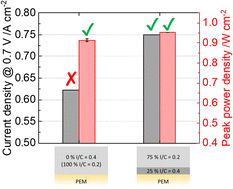Improving the efficiency of fully hydrocarbon-based proton-exchange membrane fuel cells by ionomer content gradients in cathode catalyst layers†
Abstract
Recently, the cell performances of fully hydrocarbon-based fuel cells approached those of cells with perfluorinated ionomers. Most studies used a low catalyst layer ionomer content (∼10 wt%) to enable the highest performance. However, such low ionomer contents can cause a lower cell performance, especially under application-relevant, i.e. reduced humidities (≤50% relative humidity). This work systematically investigates ionomer content gradients in cathode catalyst layers based on hydrocarbon ionomer. A graded ionomer content in the catalyst layer with a higher ionomer content in the vicinity of the membrane (I/C = 0.4, 25% of total layer) and a lower ionomer content (I/C = 0.2, 75% of entire layer) near the gas diffusion layer was found to ensure sufficient proton conductivity without compromising reactant transport. In single-cell tests at hot and dry operation conditions (H2/air, 95 °C and 50% RH), the graded layer enabled both significantly improved current density at relevant cell potentials vs. a monolithic catalyst layer (496 mA cm−2vs. 367 mA cm−2@0.7 V) and slightly increased peak performance (0.76 W cm−2vs. 0.71 W cm−2). Under the given conditions, the performance of the graded layer is similar to that of a Nafion catalyst layer. At 80% RH, the hydrocarbon-graded catalyst layer outperforms the Nafion catalyst layer at high current densities.



 Please wait while we load your content...
Please wait while we load your content...